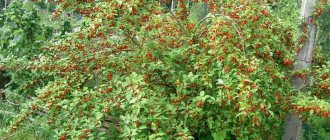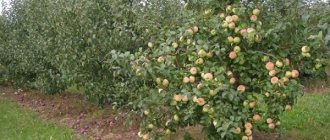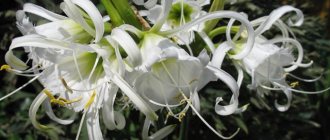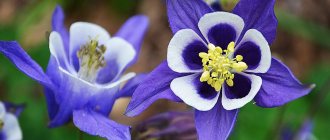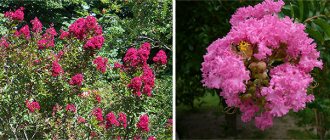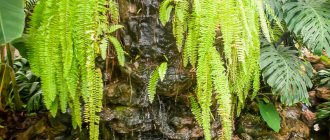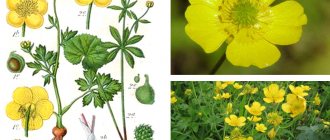Description of bear nut
The only tree of the hazel genus. In nature, 30 m tall, with a lifespan of 200 years. In Russia, tree hazel is smaller. Its height is 8 - 10 m.
The trunk of the bear nut is straight, grayish. The bark is light and consists of plates that are easily separated. The crown is dense, pyramidal, the length of the branches decreases towards the top. Young shoots have an edge that is lighter than adult branches.
The leaf plate of the hazel tree is large, heart-shaped, the apex is sharp, the edges are jagged. Young leaves are pubescent on top and hairy on the veins below. The developed leaf is smooth, brighter on top.
From spring to late autumn the foliage is green, then turns yellow, red or orange.
Long earrings (up to 10 cm) are male flowers. They remain on the tree when the leaves fall. In the spring, they are the first to “wake up”; the wind carries the ripened pollen to the female flowers. Their burgundy stigmas are barely visible from the buds. Pollination occurs. After a few days, leaves appear.
Fruits with a strong shell, 2 cm in diameter. Each nut is inside a leaf wrapper. It is wide open and shaped like a bell. The kernel is edible, tasty, but small.
The root of the bear nut is taproot and goes deep into the soil. Due to this, the breed is considered wind-resistant.
Optimal growing conditions
In the wild, bear nut, as a rule, grows on forest edges, in forest-steppes, in mountain and deciduous forests. It can also be found in areas with wet soil, and also near rivers. This tree grows best in deep calcareous soil, but it is highly not recommended to grow it in a plot with soil containing a large amount of salts.
This plant forms thickets, grows and develops normally in a shady area, and is also a fast-growing crop. There are no forests where there is only one bear nut. It grows only in mixed forests, and its “good neighbors” are: maple, hornbeam, oak and beech. Easily withstands air temperatures down to minus 30 degrees (and even lower).
Tree hazel is most widely distributed in natural conditions in Belarus, Azerbaijan, Iran, the Balkans, Ukraine, Asia Minor and Georgia. In Russia, this tree can only be found in the North Caucasus and Transcaucasia.
Advantages and disadvantages of the type
When planting a tree nut on your site or near your house, the gardener must take into account all the pros and cons of this type. The longevity of a plant can be both a positive and not so positive phenomenon. Carrots can be sown every year in different beds. Bear nut - no.
Before purchasing a hazel tree seedling, you should familiarize yourself with the disadvantages of growing it:
- edible seeds are small, like peas;
- the shell is hard, you can’t peel it with your hands, you can’t chew it with your teeth;
- transplanting a ten-meter giant is impossible. He disembarks once and for all;
- The first bear nut harvest can be harvested in the 7th year.
Now about the good stuff:
- The bear hazel tree is really beautiful! Under its dense crown the rain will not wet you;
- tolerates frost and drought well;
- easy care;
- annual harvests;
- The fruits of tree hazel are tasty, nutritious, and very healthy.
Beneficial properties of bear nut
Hazel seeds, when consumed regularly, are good for health. Nuts contain proteins, healthy fats, some carbohydrates, vitamins, and essential minerals. Bear nut is a real natural healer. With his help:
- increase hemoglobin levels and immunity;
- normalize metabolism;
- liver tissue and nerve cells are restored, wounds, cuts, and scratches heal faster;
- remove mucus from the bronchi to relieve cough;
- dissolve sand, small kidney stones;
- regulate hormonal levels and potency;
- with breastfeeding, lactation is increased;
- burn subcutaneous fat;
- return energy after hard work or physical activity.
The recommendations of the attending physician will help you choose the right direction of treatment.
Application of hazel tree
Dietary kernels are used in the food and confectionery industries. Milk, sweets, and halva are made from them. Chopped nuts complement pates, salads, and hot dishes.
Bear nut oil, obtained by cold pressing, is used for food; medicinal and cosmetic preparations, paints, and varnishes are created on its basis.
Traditional medicine contains recipes for healing with bear nuts:
- Take an equal amount of crushed nuts and honey, a tablespoon 3 times a day for anemia.
- A mixture of kernels and a glass of hot milk will stop coughing. Take morning and evening after meals.
- An infusion of hazel flowers promotes the healing of injured skin, relieves pain and swelling from varicose veins.
Bark, shells, leaves, flowers are raw materials for tinctures, infusions, and decoctions for the treatment of various diseases. Tea with leaves (1 tablespoon per glass of hot water) strengthens the nervous system and replenishes vitamins.
The wind resistance of hazel trees is used to protect plantings and strengthen the slopes of ravines. Tall, slender plants are planted along roads, in parks, and on the streets.
White wood with a pinkish tint is used for the production of furniture and finishing materials.
Hazelnut oil
The fruits of the plant contain up to 65% oils. It is obtained by cold pressing. The substance retains all nutrients and vitamins, with the exception of proteins.
The oil is used to dress salads and added to prepared meat dishes to improve and highlight the taste.
It is used in medicine - it stimulates the digestive system, increases the flow of bile, and activates hematopoiesis. The oil is used to treat skin diseases and get rid of acne. Walnut oil is a common ingredient in anti-aging creams, as it accelerates skin regeneration.
Healthy hazel oil
Planting and caring for bear nut
The best time to plant a hazel tree is early autumn. For seedlings that are 1-2 years old, the lateral roots are trimmed. The remaining root system is treated with a mixture of clay and manure.
Young hazel trees will take root and begin to grow quickly if certain planting rules are followed:
- prepare a hole half a meter deep, 60 cm by 60, there should be no other trees within a radius of 5 m;
- Place a bucket of pebbles, crushed stone, broken bricks on the bottom;
- cover the drainage with a layer of wood chips or bark;
- the next layer is rotted manure;
- compaction;
- pour out a glass of superphosphate, 1 liter of ash, a handful of rusty metal filings or nails;
- lay nutrient soil;
- Place the seedling in the prepared hole and fill it with water;
- cover the roots with a layer of fertile soil;
- lay leaves, straw, humus around the trunk;
- After a week, water the planting.
In the spring, dig up the circle around the trunk, weed out the weeds, and add 50 g of nitrogen fertilizers.
Easy care. Tree hazel is watered monthly, more often during drought. Root shoots and side shoots of bear nuts should be cut off annually in early spring.
Hazel propagation
In the forest, tree hazel reproduces by seeds, offshoots, and shoots from stumps. Root suckers are formed infrequently. The taproot of a tree goes deep underground.
In their garden plots, gardeners propagate new seedlings by suckers, cuttings, and dividing the bush.
Reproduction by taps
In spring, it is important to choose the strongest side shoot. Better annual. Gently bend it to the soil. Cover with soil, leaving the top on the surface. In summer, water bear hazel every 2 weeks. In the fall, when roots appear, separate the tree from the main plant and replant it in a new place.
Reproduction by offspring
The shoots grow from the lateral roots at a distance of 1 - 2 m from the trunk. The young hazel shoots will be ready for planting in a couple of years.
Excavate the soil around the trunk and cut off the new plant from the root. The seedling is ready for transplanting.
Reproduction by grafting
Related species can be grafted. Bear hazel is a scion for hazelnuts. This method is not reproduction. With its help, the qualities of the original plant are improved: the nuts will become larger and tastier.
The steps are simple. They can be performed by a farmer without any skills. A part of one tree is transferred to another. They grow together and new varietal characteristics are created.
The operation can be performed in spring, summer or autumn. It all depends on local climatic conditions. In the spring, the grafted bud may suffer from late frosts, and in the fall it will not have time to take root.
Gardeners consider the second half of July to be the best time for grafting. There is a high survival rate, grafting materials “stick” to each other better.
Procedure:
- Take a bud with a section of wood about 3 cm from a strong, healthy bush. It should be mature and developed.
- Choose a flat place on the scion trunk, without knots. Wipe off dirt.
- Make a T-shaped cut.
- Spread the bark along the cut.
- Insert kidney. Hold onto the wood around it. It is not advisable to touch the exposed tissue of the trunk with your hands.
- Spread out the bark. Rewind the grafting site with tape. Tight, but not tight.
- After 2 weeks, look under the bandage. If the wound begins to heal, then everything is done correctly.
Professional breeders advise taking into account that the bud may not adhere and may freeze. Incompatibility of materials, fungal diseases, and rodent attacks are possible.
Reproduction by dividing the bush
The method of propagating bear nut by dividing the bush is simple. The root system of the dug plant is chopped with a sharp shovel so that each half retains the roots (about 30 cm).
The hazel tree can now be planted in another place if the old one is no longer suitable. Hazel roots are treated with a weak solution of potassium permanganate or fine activated carbon. For disinfection.
Diseases and pests
Bear nut is resistant to various diseases and pests, as it has strong immunity. However, sometimes gardeners have problems with this tree, for example:
- Powdery mildew . You can find out that a plant is affected by this fungal disease by the appearance of a light white coating on the surface of shoots, fruits and leaf blades. As the disease progresses, an increase in plaque density is observed, and it becomes darker. Then the affected parts of the plant die. This disease reduces the tree's resistance to frost.
- White rot . This is also a fungal disease that is very dangerous for Turkish nuts. If you do not start treating the tree in time, then it may die.
- Fungal rust . In a diseased plant, orange spots form on the surface of the leaf blades. Over time, they curl up and dry out.
- Aphid . If this pest settles on a tree, then it stops forming fruits. Since aphids feed on plant cell sap, they can destroy young seedlings.
- Bud herbivorous mite . This small pest hides from the winter cold in the buds of a tree. Throughout the winter, the tick actively lays eggs in the kidneys. With the onset of spring warmth, all affected buds die.
- The nut tree bears fruit . It is a small beetle, about 1 cm long. Despite its small size, the pest is capable of destroying up to 50% of the entire crop. Females lay eggs in unripe nuts.
- Walnut leaf beetle . This pest uses bear nut foliage as food.
If the plant is affected by a fungal disease, then in order to save it, it is treated with a fungicidal preparation, for example: Falcon, copper sulfate, Topsin or Bordeaux mixture. To destroy pests, you will need to treat with an insecticidal agent, for example: Fufanon, Kemifos or Karbofos.
How to graft hazelnuts onto bear nuts using the budding method
